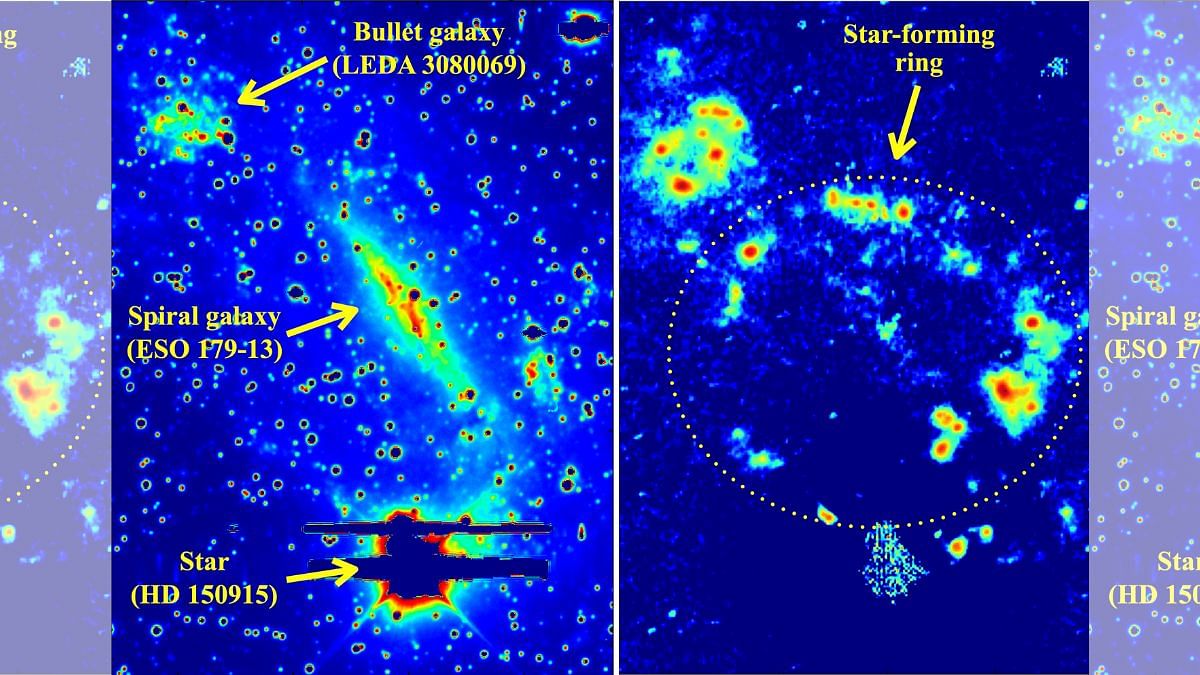Bengaluru: Astronomers from Pune’s Inter-University Centre for Astronomy and Astrophysics have identified a galaxy, known as Kathryn’s Wheel, as “an explosive factory” of gamma rays of unidentified origin. Located some 30 million light years from the Milky Way, Kathryn’s Wheel is one of the rarest kind of galaxies. It was birthed when two galaxies collided directly into each other with intense star formation activity occurring in their outer layers.
The researchers also confirmed that the galaxy — categorised as a collisional ring — was formed, when the smaller galaxy — called ‘bullet’ — pierced through the larger one. This led to a shock wave that pushed the dust and gas out of the system, leaving behind it a star-forming ring.
Published in the peer-reviewed journal The Astrophysical Journal Letters Tuesday, the analysis revealed that the data gathered about the collision of the two galactic centres and star formation merely does not explain the amount of the observed gamma ray emission.
The study noted that additional high-energy phenomena like pulsars, supernova remnants, or black holes at the centre of the galaxies need to be investigated to understand how such large amounts of gamma rays are emitted.
Some of the most powerful high-energy phenomena in the universe are gamma ray bursts. These directional beams of gamma rays originate from extremely violent astrophysical environments, such as a supernova or a black hole. If beamed directly at earth from a close source, a direct gamma ray has the potential to wipe out life, wherever it touches, through radiation.
Additionally, the team of astronomers also noticed cosmic rays — harmless high-energy particles that move almost at the speed of light — coming from the collisional galaxy. According to them, more detailed investigation is needed to determine their source inside the unique galaxy that is in our galactic neighbourhood.
Also Read: Mursan & Hilsa, now on Mars: Indian scientists name 3 craters on red planet after geophysicist, 2 towns
Churning of galaxies
The research confirmed that the ‘bullet’ galaxy was undergoing a lot of active star formation, while the centre of the larger galaxy was relatively empty as all the gases and material had been shot out of it by the impact of the ‘bullet’. This interaction continues to trigger large quantities of cosmic rays, which interact with interstellar gas and radiation fields, leading to diffused gamma ray emissions from star-forming regions, including the centre of the ‘bullet’ galaxy.
But the observed data indicated that only a minor amount of observed gamma rays can be explained by this phenomenon. As a result, the paper concluded that a “non-negligible” contribution from active galactic nuclei, and other powerful objects like pulsars, could explain the findings and need to be detected.
The gamma ray burst is thought to emanate from an unidentified source that has been named 4FGL J1647.5−5724, and was first detected in 2020. The X-ray emission sources were identified as coming from three star-forming regions, and radio sources were successfully mapped to the star-forming knots in the ring around the galaxy.
The researchers used data from telescopes for high-energy astrophysics and space observatories to observe the various types of radiation coming from the galaxy.
Need to study sources of gamma rays
Gamma rays are emanated in the form of relativistic jets — powerful jets of electromagnetic radiation moving at speeds approaching the speed of light — and made up of photons that come from active galactic nuclei, supernovae or explosions of massive stars, and other such high-energy environments.
Hunting the sources of gamma rays and other high-energy astrophysical phenomena is a key problem in research. Understanding astronomical sources that produce these intense energy beams is necessary to know how high-energy particles interact with galactic environments.
Studying these particles is also opening up a new field in physics — the study of neutrinos: exotic, tiny collapsed atoms of dead stars that pass through everything without causing any damage. Understanding high-energy physics also helps in furthering research into dark matter and dark energy, which are thought to make up a majority of the known universe.
(Edited by Mannat Chugh)
Also Read: IIT-Madras, NASA jointly study multidrug-resistant pathogens on International Space Station

